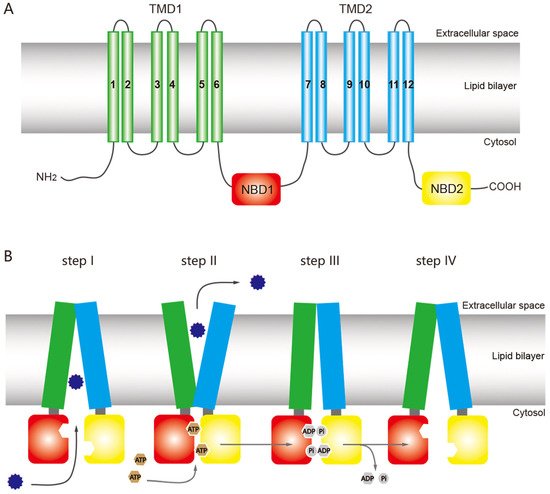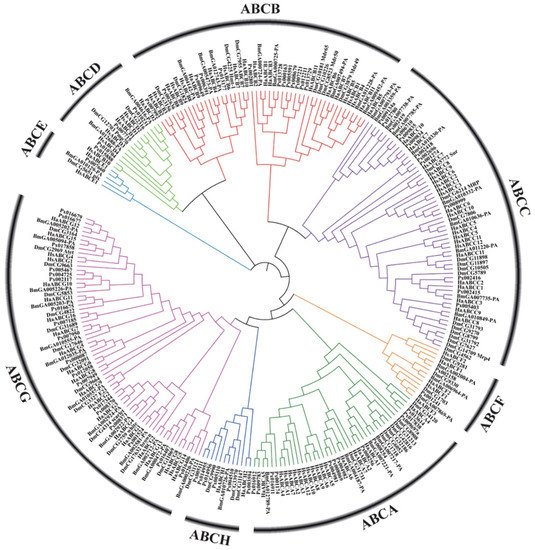4. ABC Transporter Roles in Bt Insecticidal Activity
The ABC transporters that act as Bt-toxin receptor belong to subfamilies A, B, C and G (
Table 2). With the long-term cultivation of Bt cotton, field resistance to Cry2Ab toxin evolved in
H. armigera. The resistance of two
H. armigera strains to Cry2Ab was an independent evolutionary event involving different deletion mutations, which were located in different exons of the same
ABCA2 gene
[53]. A homologous deletion in
HaABCA2 was also detected in resistant lines of
H. punctigera Cry2Ab. A similar situation was also found in resistant lines of
Pectinophora gossypiella; a loss of
PgABCA2 exon 6 was caused by alternative splicing in resistant larvae of laboratory-selected strains in Arizona and field-selected strains in India
[54]. In addition, insect ABCA2 was expressed in the midgut where the Cry2Ab toxin binds
[53][55]. A bioassay of two strains of
H. armigera with CRISPR/cas9 knockout of
HaABCA2 showed that
HaABCA2 plays an important role in mediating resistance to Cry2Aa and Cry2Ab
[56].
Table 2. Bt toxins and their possible corresponding ABC transporters as receptors in insects.
| Bt toxin |
Receptor |
Target pest |
Reference |
| Cry1Aa |
ABCC2 |
Bombyx mori |
[57] |
| Cry1Ab |
ABCC2 |
Bombyx mori |
[58] |
| |
ABCG1 |
Ostrinia furnacalis |
[59] |
| Cry1Ac |
ABCC2 |
Helicoverpa armigera |
[60] |
| |
ABCC2 |
Heliothis virescens |
[61] |
| |
ABCG1 |
Ostrinia furnacalis |
[59] |
| |
ABCG1 |
Plutella xylostella |
[62] |
| |
ABCC2 |
Plutella xylostella |
[63] |
| |
ABCC2 |
Spodoptera exigua |
[64] |
| |
ABCC3 |
Spodoptera frugiperda |
[65] |
| Cry1Ca |
ABCC2 |
Spodoptera exigua |
[64] |
| Cry1Fa |
ABCC2 |
Ostrinia nubilalis |
[66] |
| Cry2Aa |
ABCA2 |
Helicoverpa armigera |
[56] |
| Cry2Ab |
ABCA2 |
Helicoverpa armigera |
[53] |
| |
ABCA2 |
Helicoverpa punctigera |
[53] |
| |
ABCA2 |
Pectinophora gossypiella |
[54] |
| Cry3Aa |
ABCB1 |
Chrysomela tremuela |
[67] |
| Cry3Bb1 |
ABCB1 |
Diabrotica virgifera virgifera |
[68] |
A
Chrysomela tremuela strain survived and reproduced on transgenic poplar trees that expressed a high level of Cry3Aa Bt toxin, and its Cry3Aa resistance was an autosomal recessive trait. Candidate resistance genes were analyzed using midgut transcriptome of larvae, demonstrating that a mutation of the
ABCB homolog of
P-gp was closely linked to the resistance of Cry3Aa, and named
CtABCB1. A 4-bp deletion in
CtABCB1 introduced a frame shift with a premature stop codon, resulting in the loss of transporter signature motifs 1 (TpM1) and transmembrane domain 2 (TMD2)
[67]. A
CtABCB1 homologous gene in western corn rootworm (
Diabrotica virgifera virgifera) was also shown to be genetically linked to Cry3Bb1 resistance
[68]. Perhaps the insect ABCB1 transporter is a receptor specific for Cry3 toxin, and structural changes in this transporter may be associated with Cry3 toxin resistance of the insect.
Some ABCC transporters are a functional receptor for more than one Cry1A toxin. The binding of Cry1Ac toxin to ABCC2 on membrane vesicles can lead to membrane perforation. Bretschneider et al. studied the relationship between the ABCC2 of
Heliothis virescens and cytotoxicity of three Cry1A toxins (Cry1Aa, Cry1Ab, Cry1Ac) in
Spodoptera frugiperda Sf9 cells and found that ABCC2 is the central target of Cry1A toxin action
[69]. Heterologous expression in
D. melanogaster has been used to validate the involvement of ABCC2 in Cry1Ac toxin binding
[70]. An inactivating mutation, such as mis-splicing of
ABCC2 or a mutation causing a single amino acid change, could reduce binding of Cry1Ac toxin, conferring high levels of Bt resistance in the target pest
[60][61][71]. In a Cry1Ac-resistant strain of
P. xylostella with a 30-bp deletion in exon 20, was expected to cause the removal of the 12th transmembrane (TM) domain and carboxyl terminal of TM12 that is located outside the cell. The mutation may result in the lack of function of a core ATP-binding loop
[63]. In addition, an ABCC transporter is also the receptor of Cry1Ca and Cry1Fa toxins
[64][66]. A cytotoxicity assay showed that the binding affinity of ABCC transporters to Cry toxin was largely linked to the susceptibility of receptor-expressing cells to Cry toxin and that the extracellular loop (ECL) structures determine the specificity of ABCC to Cry toxins
[72].
Bt resistance mediated by ABCC transporters involves not only different forms of gene mutations, but also the regulation of
ABCC gene expression. The study of Bt resistance in hybrid larvae of
B. mori revealed a
trans-regulatory mechanism involved in the allele-specific expression of
ABCC2 in response to Cry1Ab toxin, which may play an important role in insect Bt resistance
[58]. The binding of Cry1Ac toxin to ABCC transporters that causes midgut membrane perforation is regulated by a constitutively and transcriptionally activated upstream gene (
MAP4K4) in the MAPK signaling pathway
[62]. In addition, Forkhead box protein A (FOXA) upregulates expression of
ABCC2 and
ABCC3 genes in Sf9 cells
[65]. ABCC2 and ABCC3 are important receptors of Cry1Ac toxin, and their expression level has a significant influence on insect Bt resistance; thus, FOXA may be involved in the regulation of insect resistance to Cry1Ac toxin.
ABCG1 (
white) gene is one of the most widely studied members of the ABCG protein subfamily. The white protein in
P. xylostella is located on the cell membrane, and the expression of
Pxwhite gene in the midgut of a Bt-resistant population is significantly lower than in a susceptible population. After RNAi silencing of the midgut
Pxwhite gene, the sensitivity of the larvae to Bt-Cry1Ac toxin significantly decreased
[73]. Genetic linkage analysis confirmed that the decrease was closely linked to the Bt-Cry1Ac resistance of the moth. Downregulated expression of ABCG subfamily genes in
Ostrinia furnacalis is also related to its resistance to Cry1Ab and Cry1Ac toxins
[59].


